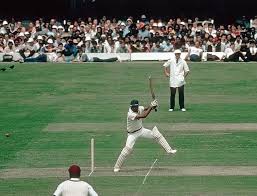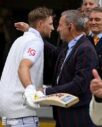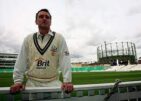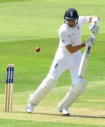India, West Indies and the ‘other’ 1983 – Part 1
Gareth Bland |
This year marks the 40th anniversary of the most romantic episode in Indian cricket history. On 25th June 1983 Kapil Dev stood on the balcony as the Lord’s twilight loomed and held aloft the Prudential World Cup. Their opponents, West Indies, had been expected to cruise to a third consecutive world crown. Having won the inaugural tournament in 1975, and then followed up with another for good measure in 1979, Clive Lloyd’s team crumbled in their pursuit of a relatively meagre total of 184 and India delivered the ultimate cricketing cup shock.
West Indies featured heavily in India’s 1983. Although India pulled off the shock of the century in the English summer with their World Cup win, they were not so lucky months earlier during their tour of the Caribbean when, true to form, the home team brushed the tourists aside 2-0 in the five Test series. Later in the year West Indies travelled to India for what became known as the “Revenge Series”. Beginning in early October 1983 and ending on New Year’s Eve, the visitors demolished their hosts 3-0 in the 6-Test series and pummeled them 5-0 for a clean sweep in the limited overs games.
This story, then, focuses on India, West Indies and the ‘other’ 1983. A tale of one of the most formidable units in the history of the game at home and abroad. As a result of their demolition of India in India that year, cricket writer Sidhanta Patnaik dubbed Lloyd’s team “The Unforgettables”. Even so, as 1983 dawned the West Indies board and the team itself faced one of the most contentious chapters in Caribbean cricket history.
Prior to the start of the series with India in early 1983 it was announced that a team of West Indies “rebels” would follow in the footsteps of the South African Breweries backed England team and tour Apartheid South Africa. Captained by Lawrence Rowe, and managed by Albert Padmore, the squad consisted of Richard Austin, Herbert Chang, Sylvester Clarke, Colin Croft, Alvin Greenridge, Bernard Julien, Alvin Kallicharran, Collis King, Everton Mattis, Ezra Moseley, David Murray, Derick Parry, Franklyn Stephenson, Ray Wynter and Emmerson [DW(1] Trotman. Of those, only Croft, then 30 and increasingly injury prone, Clarke, 28, Moseley, 24, and Stephenson, 23, could be said to have been genuine contenders for a place in a full-strength West Indies team.
Both Croft and Clarke had played in the West Indies’ last Test series, on the 1981/82 tour of Australia, although Clive Lloyd’s team had not played any international cricket since January 1982 when they returned from Down Under. Clarke, disenchanted with a dearth of opportunities, Croft, unsure of the longevity of his dodgy knees at the top level, and the rest of the party received a then lucrative $100,000-150,000 for their services. Immediate bans followed, as did ostracization both social and professionally across the Caribbean.
Many of the touring party were, however, players whose best days were behind them at international level while most cited poor pay in the West Indies domestic game, as well as a lack of guaranteed – or at best sporadic – employment during the off-season as their reasons for jumping ship.
India came to the Caribbean fresh from combat with a peak Imran Khan and his Pakistan team. Losing a 6-Test rubber 3-0, and a limited overs series 3-1, they had clearly been second best throughout the Pakistan tour. Imran’s speed, leadership and intelligence had shone throughout, although there were at least some bright spots for India.
Recalled to the side for the Pakistan series after a three-year international hiatus, Mohinder Amarnath hit 584 runs at 73 with three centuries and 3 fifties. Kapil Dev had also bowled tirelessly as India’s spearhead. Changes were unavoidable, however. After a lean series in Pakistan where he eked out just 134 runs at 16.75 in the 6 Tests, Gundappa Viswanath was dropped from the team, never to return. Silky smoothness personified; Gavaskar’s brother-in-law found himself surplus to requirements at the age of 34. For Gavaskar himself, defeat in Pakistan meant change for him, too, as he was dismissed as captain and replaced by the 24-year-old Haryana Hurricane Kapil Dev.
For West Indies, despite the background noise created by the rebel tour to South Africa, their XI for the first Test at Sabina Park represented only two changes from the last Test line-up in Adelaide fourteen months earlier. For Croft, in came Malcolm Marshall, then two months shy of his 25th birthday and with his peak years to come. Out went Faoud Bacchus in the middle order and in came Gus Logie in an otherwise unchanged team. After a drawn pre-Test series pipe-opener with Jamaica the first Test at Sabina Park began on February 23rd.
In a low scoring game West Indies ran out winners by a four-wicket margin. Put into bat by Lloyd, India struggled to 251, made possible by a four and a half hour 63 from Yashpal Sharma and a gutsy 68 from the young seamer Balwinder Sandhu. West Indies found conditions no more to their liking and finished all out 254, thanks largely to Greenidge’s five hour 70.
As India went in for their second innings, an old rivalry played out in electrifying style in front of the Sabina Park faithful. With the very first ball of the second innings Michael Holding’s smooth glide up to the stumps and sinuous delivery of the ball picked out one of many vipers in the pitch and clean bowled Gavaskar leg stump, behind his legs. Anshuman Gaekwad and Mohinder Amarnath calmed Indian nerves in a partnership of 68, although the innings never gained momentum as India slid to 174.
That old stager, Andy Roberts, at 32 and in what would be his last home series, took 5-39 off 24.3 overs. Set a target of 172 for victory, and with no play possible on a rain-ruined fourth day, the home side rattled up the runs required on the final day, in just 25.2 overs, with a 36-ball 61 from Viv Richards, which included five 4s and four 6s.
Drawn Test matches at Port of Spain and Georgetown, Guyana followed. In the 2nd Test at Port of Spain, Clive Lloyd hit 143 for the West Indies in their 394, while Mohinder Amarnath struck a match-saving 117 in the Indian second innings to help his side avoid an innings defeat. Amarnath’s second innings century improved on his first innings 58 and continued his magnificent run of form. On to Clive Lloyd’s home ground and a rain-lashed 3rd Test at Georgetown was noteworthy for the only significant Gavaskar innings of the tour; a perfectly crafted 147 out of India’s 284/3.
Normal West Indian service resumed in the fourth Test in Barbados where Lloyd won the toss and elected to field first. India limped to 209 with Amarnath again – and alone – standing in the way with 91. Gus Logie top scored in the West Indies reply with 130 as the home side compiled 486. In a scarcely improved Indian second innings Amarnath again top scored, this time with 80, and Andy Roberts again took four wickets, this time for just 31 runs from 19.2 overs. Two-nil up after four Tests, the West Indies lead was unassailable.
For the final test in Antigua West Indies again won the toss and Lloyd once more asked India to bat first. A Ravi Shastri hundred, coming in at number six, along with a rapid fire 98 from Kapil Dev, 94 from Vengsarkar and, yet again, runs from Amarnath (just 54 on this occasion) meant India totaled 457. In a slightly rejigged line-up for the final Test, Joel Garner was dropped, and Winston Davis was given his Test bow.
In the Windies reply four of the regular top seven scored centuries, with Haynes making 136, Dujon 110, and Lloyd 106. It was the circumstances surrounding Gordon Greenidge’s 154 which understandably caught the most attention, though. Surmounting unimaginable emotional anguish, the great opener retired with his score on 154 to see his dying daughter Ria in hospital. As a mark of respect an exception was made to the Laws of Cricket as the Bajan was classified as “retired not out”. At the conclusion of hostilities in Antigua West Indies had won the series 2-0 with bad weather having had a significant say in the three drawn Test matches, as indeed had Indian obduracy.
For India, Mohinder Amarnath stood head and shoulders above his teammates as his 598 Test runs came at 66.44. Kapil Dev had weighed in with 254 at 42.33, while Shastri, Yashpal Sharma, and Vengsarkar had all contributed sporadically. With the ball the tourists had relied heavily on their skipper, whose 17 wickets at 24.94 proved beyond doubt that he was the sole performer of potency who could threaten the West Indies top order.
Another Indian national icon had weathered an undeniably leaner time of things. Although Sunil Gavaskar had made 147 in Georgetown, he had only managed a further 93 runs in his other 8 Test innings. Questions were being asked about his appetite for the short and fast stuff, and his ability to top the order and weather the inevitable onslaught from the pace battery. That he was to turn this round in such thrillingly attacking fashion when West Indies visited India later in 1983 is one of the great chapters in the Gavaskar story. In the early months of 1983, however, this was some way off and the world’s premier opening batsman brooded over his loss of form during the first half of the year.
For West Indies, the return to the international arena after a fourteen-month break had been a successful and reassuring one, in which the upheaval of the rebel tour was relegated to a side show – at least while Clive Lloyd’s team was out on the field. Off it, the repercussions of the South Africa tour would have manifest consequences across the region for years to come.
The on-field impression was of a slickly smooth and formidable machine coming back to life, gradually going through the gears to achieve peak efficiency. In this series all the batsmen had scored a century, although some had cashed in more than others. Greenidge had topped the averages with 393 at 78.60, while Lloyd had top scored with 407 at 67.83. Moreover, both Haynes and Dujon had averaged in excess of 50. That old warhorse A.M.E. Roberts had topped the bowling with 24 wickets at 22.70 and Marshall had seamlessly replaced Croft with 21 wickets at 23.57. Those other two seasoned operators, Holding and Garner, had looked less effective on paper, but would eventually raise their levels to optimum performance.
With the series ending on 3 May the next stop for both teams was England and the Prudential World Cup, beginning 9 June. They would meet again at the World Cup, with group stage encounters at Old Trafford and The Oval and then, in unforgettable and improbable fashion, in the final itself at Lord’s on 25 June. Of the two teams packing up their kit bags in the Caribbean and heading for the World Cup, one was a heavy favourite to achieve their third consecutive title, while the other was a 66-1 outsider. Reality, circumstance, and romance, though, have a strange habit of upsetting the bookies.





Worth noting that in the first Test India were 167-6 at tea on the final day; Roberts then took the last 4 wickets in 20 balls, and West Indies reached the target of 172 with 4 balls to spare.
Comment by AndrewB | 12:41am GMT 25 January 2023
Great piece, Gareth!
Comment by David Wilson | 5:19am GMT 31 January 2023